Toshiba Develops World’s First Double-Gate RC-IEGT, Reduces Switching Loss
June 15, 2022
Toshiba Electronic Devices & Storage Corporation
Toshiba Corporation
KAWASAKI--Toshiba Electronic Devices & Storage Corporation and Toshiba Corporation (collectively “Toshiba”) have together developed the world’s first[1] 4.5-kV double-gate reverse-conducting injection-enhanced gate transistor (RC-IEGT[2][3]). Toshiba confirmed a total power loss, when switching on and off (switching loss), reduction of 24%[4] compared with the conventional single-gate structure.
Power devices, components that supply and manage power, are essential to reduce power consumption in all kinds of electronic equipment and to achieve a carbon neutral society. In the global trend to decarbonization and energy saving, IEGTs are used in a wide range of applications, such as high power inverters and high-voltage DC power transmission, where they are required to have higher current and efficiency, and lower power losses and consumption. It is difficult to reduce power loss in IEGT, as there is a trade-off whereby reducing the loss when the IEGT is on (conduction loss) increases switching loss.
Toshiba developed a 4.5-kV double-gate RC-IEGT with a hole control gate (CG) separate from the main gate (MG). This approach achieves loss reduction by controlling hole extraction before turn-off and injection compared with reverse recovery in a single device. In IEGT mode, where current flows from the back side to the front side of the substrate, the CG is turned off before the MG at turn-off to reduce the holes accumulated in the substrate and reduce the turn-off loss[5].In diode mode, where current flows from the front side to the back side of the substrate, by turning on MG and CG at the same time just before reverse recovery, electrons accumulated in the substrate are reduced and reverse recovery loss[6] is reduced.
By combining the newly developed double-gate RC-IEGT and gate control technologies, turn-off and turn-on losses[7] were reduced by 24% and 18%[4], respectively, and reverse recovery loss was reduced by 32%[4], against the conventional single-gate structure. As a result, total switching loss was reduced by 24%[4] without any increase in conduction loss in actually measured values.
Details of the achievement were reported at the IEEE International Symposium on Power Semiconductor Devices and ICs (ISPSD) 2022, an international conference held in Vancouver, Canada and online on May 22 to 25.
Toshiba will continue to develop double-gate RC-IEGT and gate control technologies, aiming for commercialization in and beyond 2025. Toshiba is committed to contributing to carbon neutrality through supporting the higher performance of power electronics equipment.
Notes:
[1] As of May 2022, Toshiba research.
[2] IEGT: Injection Enhanced Gate Transistor. IEGT improves the sharp increase of the on-state voltage accompanying the increase in collector-emitter voltage by devising the element structure of the emitter of the IGBT (Insulated Gate Bipolar Transistor).
[3] RC-IEGT: Reverse Conducting IEGT. IEGT and free wheel diode (FWD) integrated on a single chip. IEGT operates by admitting electrons from the emitter on the front side of the substrate and holes from the collector on the back side of the substrate when a voltage is applied to the gate, while RC-IEGT operates by admitting holes from the front side and electrons from the back side, FWD operation that allows current to flow in the opposite direction is also possible.
[4] Comparison with Toshiba’s current single gate IEGT; Toshiba test results.
[5] Turn-off loss: Power loss that occurs when an IEGT switches from on to off.
[6] Reverse recovery loss: Power loss that occurs when an FWD switches from on to off.
[7] Turn-on loss: Power loss that occurs when an IEGT switches from off to on.
The structure of Toshiba’s new Double-Gate RC-IEGT
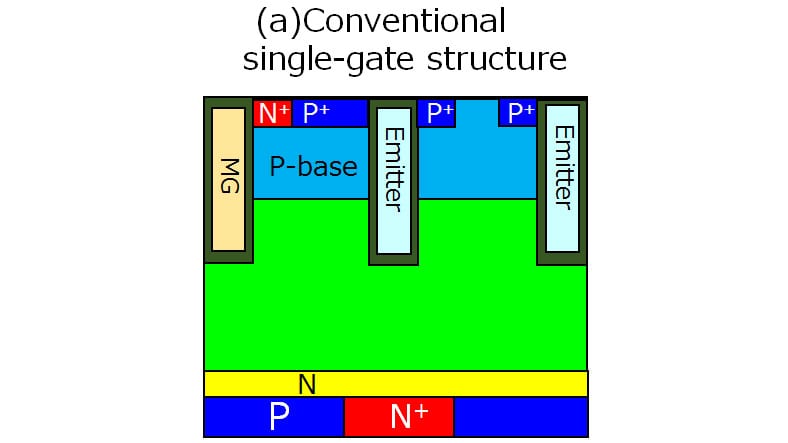
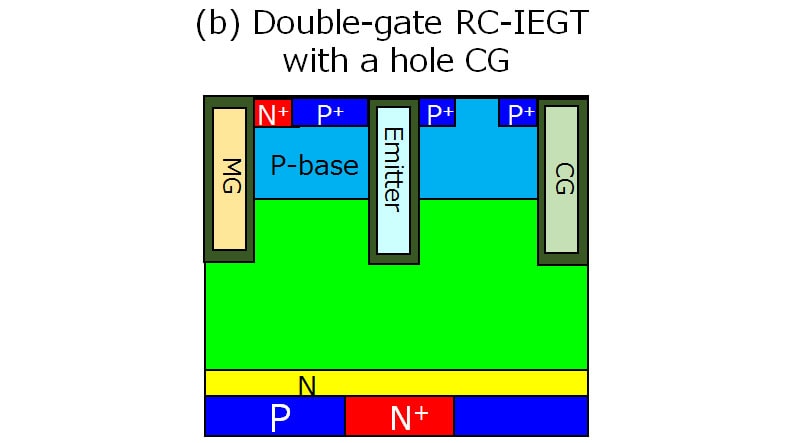

Actual measurement of switching waveform (Toshiba test results)
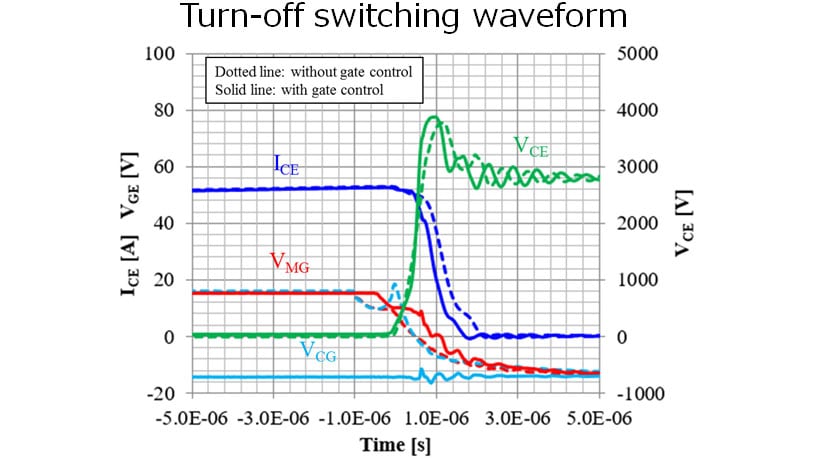
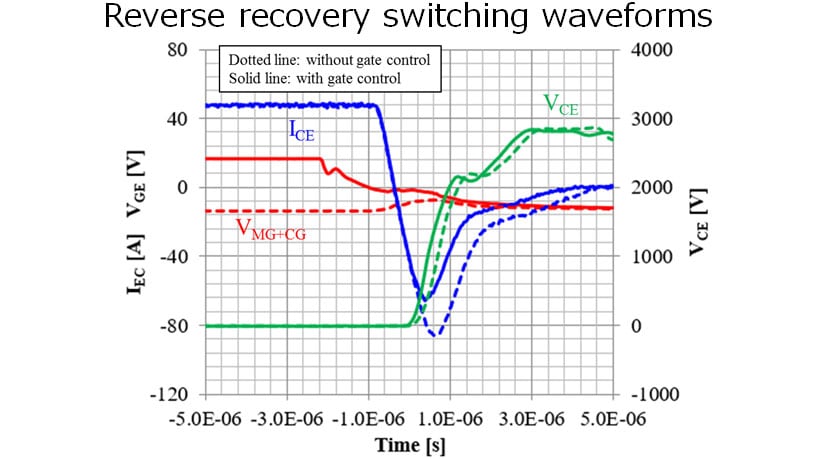
Actual measurement of switching loss reduction (Toshiba test results)
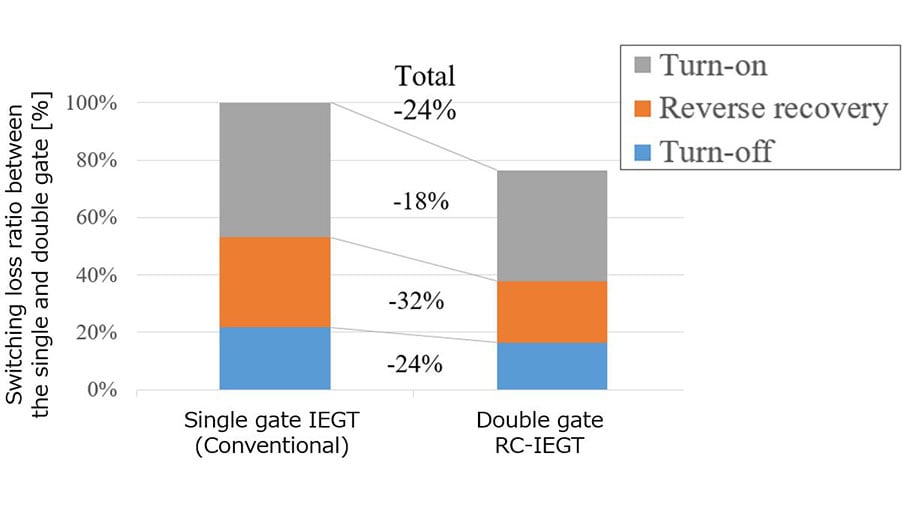
* Company names, product names, and service names may be trademarks of their respective companies.
* Information in this document, including product prices and specifications, content of services and contact information, is current on the date of the announcement but is subject to change without prior notice.